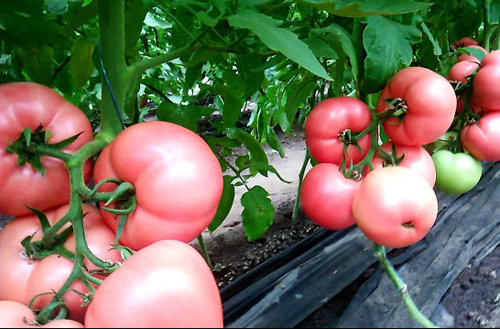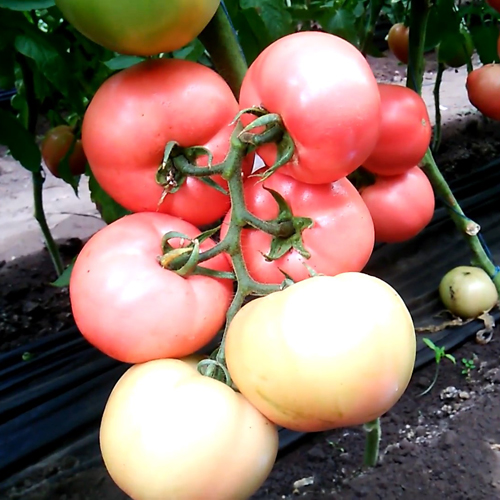Tomato variety Manuza (F1)
Tomatoes from the Dutch company Rijk Zwaan, or Rijk Zwaan, are well known to both professional vegetable growers and amateurs. Recently, breeders have delighted with the newest pink-fruited variety called Manuza (Manusa). In the State Register of Breeding Achievements of Russia, the new variety was introduced in 2016 and received permission to cultivate in all regions of the country. Recommended for growing under plastic shelters and in plastic greenhouses. Our hero is also suitable for polycarbonate greenhouses, but ineffective in glass ones. The culture is used in both the first and second revolution. It is a hybrid, therefore it is labeled F1.

Description
The plant is classified as indeterminate, with unlimited growth, with a height of 1.8 to 3.0 meters. The bush is balanced. The root system is powerful. The stem is strong, the foliage is good. Leaves are medium in size or slightly larger, deep green in color, regular shape, slightly wrinkled surface. The internodes are short. The inflorescence is simple. The first fruit cluster is formed after 9 leaves, in each of them there are mainly from 4 to 5 ovaries, sometimes 6. The load of the plant is high, 6 inflorescences are formed on the central stem.
The fruits of the variety are flat-round, dense, smooth, uniform throughout the entire growing period. The skin is thin, slightly shiny. In an immature form, the color of the fruit is green, without a dark spot at the stalk. A ripe tomato turns into a delicious pink color. The pulp is fleshy, tender, juicy, but not watery, multi-chambered - there are more than 6 seed chambers. The official source describes the taste as excellent. Tomatoes are quite large, the originators declare a weight of 220 - 300 grams. The State Register gives other indicators - 100 - 150 grams.

Characteristics
- The originators classify Manusa as an early maturing crop. But the State Register specifies - the plant is mid-season, from the moment of full sprouting to the beginning of ripening, it takes 105 - 115 days. The yield is friendly. The growing season is 60 - 70 days;
- in the description of the hybrid, its high yield is declared, without specific data. The State Register recorded the yield of marketable fruits in film greenhouses at the level of 5.6 kg per 1 square meter;
- the variety has strong immunity. There is a high resistance to tomato mosaic virus (race 0: 2), brown spot, fusarium wilt, verticillium wilt. The variety is moderately resistant to spotted wilt virus. But as practice has shown, it can suffer from pests - whitefly and scoop caterpillars;
- there is a high resistance of tomatoes to cracking;
- transportability and keeping quality at a high level, dense fruit pulp does not suffer from long-term transportation;
- the method of consumption, according to the State Register, is salad. The dense, low-water pulp is good for slicing, it can be used to decorate ready-made dishes.
Agrotechnics
Tomatoes are grown in seedlings. The sowing period is calculated independently, taking into account the climatic features of the region. Tentative dates in central Russia are late March - early April. The recommended planting density is 3 bushes per square meter. The garter is required, the formation is carried out in 1 - 2 stems. In order for the fruits to acquire a richer color, good lighting is needed.
Vegetable growers are just beginning to get acquainted with the Manusa hybrid, but first impressions are positive. The plant is well loaded, all the fruits ripen in the brush, the marketability of tomatoes is very high, the taste is good. The grooming is the same as for other indeterminate varieties - garter and shaping is needed. The seeds will have to be purchased annually.








